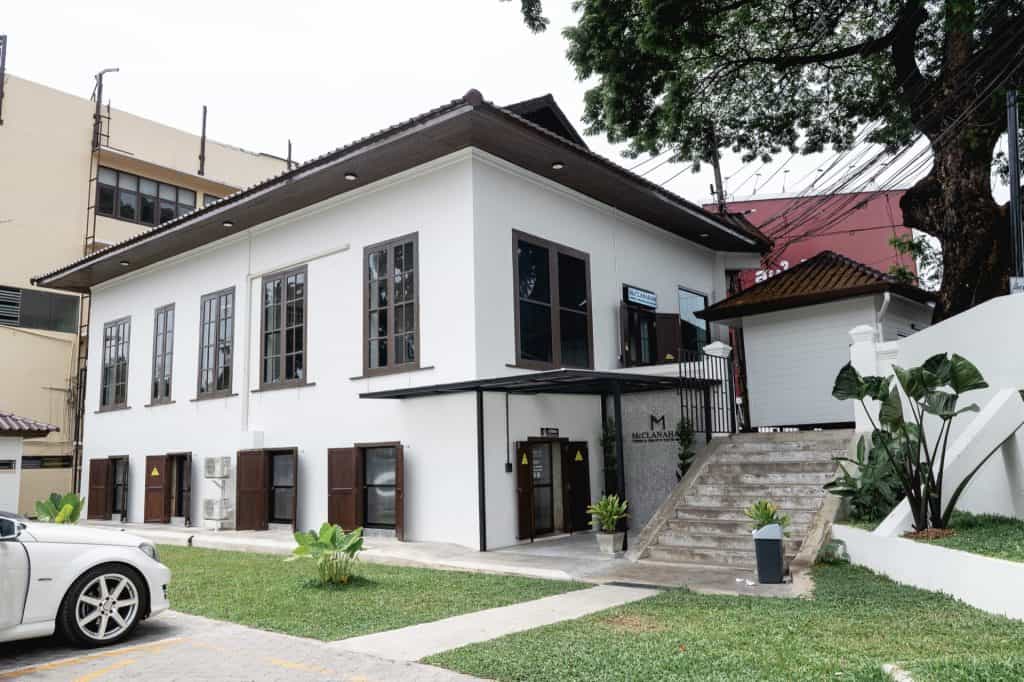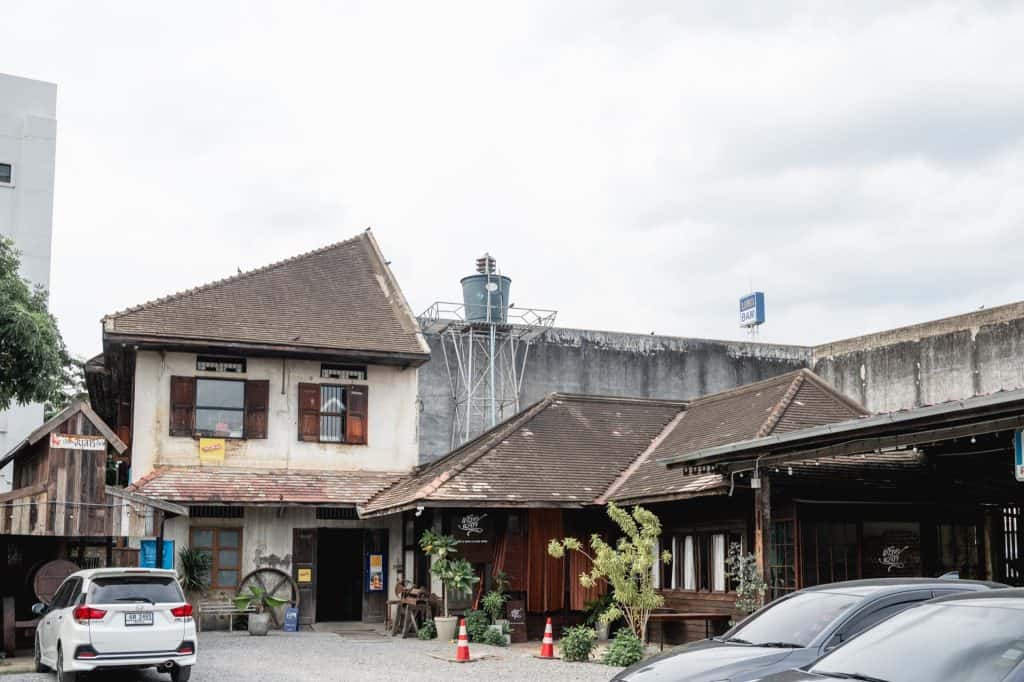San Pa Koi
The pin point of Chiang Mai's
modern history
San Pa Khoi area Charoen Mueang Road is an important area in the modern history of Chiang Mai because it was a transitional area during which the city developed from being the center of power of the Lanna Kingdom, a traditional state of Siam.

Cultural and economic heritage of the San Pa Khoi and Wat Ket areas
San Pa Khoi history
San Pa Khoi and Charoen Mueang Road An area with a history of many eras following the city's development. You can study neighborhood changes from this timeline.
Period 1: Chiang Mai Encountering Western Civilization (1867-1894)
-
1867 The arrival of Dr.McGilvary, American Presbysterian Missionary
-
1868 King Kawiloros Suriyawong built San Pa Khoi Temple
-
1873 1st Chiang Mai Treaty signed between Siam and Western Colonial Powers
-
1875 Dr. McGilvary completed his teakwood residence on the east of Ping River
-
1876 - 1878 Mission Girl School was established on the east bank of Ping River
-
1883 2nd Chiang Mai Treaty signed Colonial Power recognized Siamese rule
-
1883 (1883) Siam Postal Service was established
-
1884 British Borneo Co. located near Dr. McGilvary’s residence at the north
- 1884 Sawmill, hospital, and shipyard on the west bank of Ping River by a British Borneo Co. manager and American missionary-Dr. Marian Cheek
- 1886 Forestry Department was established
- 1887 Electricity operated by private business
- 1887 (1887) Mission Boy School was established on west bank of Ping River
- 1888 American Mission Hospital was established on the west bank
- 1890 Church of Chiang Mai, school and US. missionary residence were built
- 1891 British Consulate Office and residence were built on both side of Ping River
- 1891 Bombay Burma Company established its office
- 1894 Region or Monthon Lao Chiang was established
-
Period 2: Chiang Mai as a part of Siamese Colonial Economy
- 1894 Region or Monthon Lao Chiang was established
- 1894 Chiang Mai, Chiang Rai, Lampang, Lamphun, Phrae, and Nan united as Monthon Lao Chiang
- 1898 Gymkhana Sport Club was founded by missionaries, teak businessmen and Siamese elites
- 1901 Monthon Lao Chiang Region was renamed to Monthon Phayab.
- New Siamese regional governor ordered to expand rural road network Charoenmueang Rd.
- Chiang Mai-San Kamphaeng) was built and Gum Tree Rd. (Chiang Mai- Lamphun) was built.
- 1901 New ruler of Chiang Mai, Prince Intrawarorot initiated electricity in the town Famous Sino-Thai merchant, Luang Anusarn, built shophouse at Charoenmueang Rd.
- 1901 Famous Sino-Thai merchant, Luang Anusarn, built shophouse at Charoenmueang Rd.
- 1903 Siamese army headquarter was built in the south of San Pa Khoi
- 1905 Mission Boy School moved to the north of San Pa Khoi and renamed to Prince Royal College School
- 1910 The main market, Kad Luang was constructed on the former royal funeral ground
- 1916 First medical college started
- 1917 - 1926 San Pa Khoi market was constructed
- 1921 Railroad reached Chiang Mai
Period 3: Chiang Mai and the world
- 1917 - 1926 San Pa Khoi market was constructed
- 1921 Railroad reached Chiang Mai
- 1924 American Mission Hospital moved to the north of San Pa Khoi
- 1927 First bank (Siam Commercial Bank) opened in Chiang Mai, It was opposite to the Railway Station
- 1929 The new assembly hall of Wat San Pa khoi was reconstructed
- 1931 Transfer of electric power from municipality to Provincial Electric Authority
- 1932 People Revolution ended the absolute monarchy of Siam
- 1933 Chiang Mai became a province of Siam
- 1934 Indigenous Christians found Church of Christ in Thailand-CCT
- 1935 Municipality of Chiang Mai was upgraded to City of Chiang Mai
- 1940 First mayor of City of Chiang Mai and first MP were residents of San Pa Khoi
- WWII broke out Japanese Army in Chiang Mai, American Missionaries escaped back to the USA
- 1952 Transportation Act was passed
- The expansion of Chiang Mai - San kampaeng road and the construction of Hod-Lamphang-Lamhun road
- 1955 First radio broadcasting station operated in Kawila Arrny Camp
- 1959 The establishment of Provincial Electricity Authority at Wua Lai Road
- 1965 Chiang Mai-Lampang Rd. was upgraded to Super highway
- 1966 First bus terminal was constructed at the North gateway of the city
- 1967 Shinthassanee Cinema was opened on Charoenmueang Rd.
- 1968 The great fire of Kad Luang (Warorot Market).
- 1972 The reconstruction of Warorot Market
- 1983 Second bus terminal was constructed at the West
Modern Chiang Mai
San Pa Khoi and Wat Ket areas as the starting point of modern Chiang Mai. Because it was an area that supported the arrival of Westerners and missionaries. It includes economic and social activities related to colonization, the teak trade, and Christianity.
Cultural and economic changes
San Pa Khoi and Wat Ket areas. At first, this area was characterized as a community of Westerners and missionaries, but later the role of Westerners and missionaries decreased. The Chinese community has taken on an increasing role. As a result, the San Pa Khoi and Wat Ket areas have become important commercial and business areas of Chiang Mai.
San Pa Koi -
Charoen Muang District
Small Business Hub
Charoen Muang may be home to a diverse range of small businesses such as cafes, boutiques, and local crafts shops that contribute to the local economy.
Delicious Eats
Charoen Muang may have some unique local delicacies, food stalls, or restaurants serving mouth-watering dishes that are worth exploring.
Heritage Trail
Charoen Muang may have some cultural and historic landmarks, temples, or museums that reflect the district’s history and cultural heritage.
Relaxing Retreat
Charoen Muang may have some parks, gardens, or lakeside areas that offer a peaceful and relaxing atmosphere for residents and visitors to unwind and recharge.
Discover San Pa Khoi-Charoen Mueang
Cultural and economic heritage of the San Pa Khoi and Wat Ket areas The area still has western and local style buildings. It reflects the cultural and economic development of this community very well.
ย้อนอ่านประวัติศาสตร์ “อาคารสำคัญย่านสันป่าข่อย”
พื้นที่ย่านสันป่าข่อยที่ชาวเชียงใหม่สามารถนึกถึงได้นั้นอาจมีความต่อเนื่องตั้งแต่บริเวณ ถนนเจริญเมือง (ถนนสันกำแพงเดิม) ตัดกับถนนเจริญราษฎร์และบรรจบกับสะพานนวรัฐ ไปทางเหนือรวมพื้นที่ย่านวัดเกตุจรดถนนแก้วนวรัตน์และลงไปใต้จนถึงยิมคาน่าและโรงไฟฟ้าบ้านเด่น ตลอดจนพื้นที่ชุมชนที่พักอาศัยโดยรอบเขตค่ายกาวิละ อาคารกลุ่มแรกที่เริ่มสร้างขึ้นในย่านสันป่าข่อยและเป็นจุดเริ่มต้นของการเปลี่ยนแปลง กลุ่มอาคารของคณะมิชชันนารี อเมริกันเพรสบีสทีเรียน ที่เข้ามาตั้งแต่ พ.ศ. ๒๔๑๐ แต่ได้มีการปลูกสร้างบ้านพักมิชชันนารีและโบสถ์คริสตจักรแห่งแรกซึ่งเป็นอาคารถาวรสร้างด้วยไม้สักบนพื้นที่ฝั่งตะวันออกของแม่น้ำปิงในช่วงปี พ.ศ.๒๔๓๐-๒๔๓๔ โดยที่ อาคารโบสถ์คริสต์หลังนี้เป็นหลังเดียวที่ยังคงอยู่มาจนถึงปัจจุบันกลายเป็นส่วนหนึ่งของโรงเรียนเชียงใหม่คริสเตียน(Chiang Mai Christian School) ซึ่งนับเป็นอาคารรูปแบบตะวันตกกลุ่มแรกในเมืองเชียงใหม่และได้รับการยกย่องเป็นสถาปัตยกรรมที่ควรค่าแก่การอนุรักษ์ประจำปี พ.ศ. ๒๕๕๘ โบสถ์หลังนี้นับว่าเป็นสถาปัตยกรรมแบบชนบทอเมริกัน (American Country style) โดยในสมัยช่วงเวลานี้เริ่มมีการเข้ามาของบริษัทรับสัมปทานตัดไม้สักจากประเทศอาณานิคมตะวันตก ทำให้โครงสร้างอาคารยุคนี้มีวัสดุหลักคือไม้สักแปรรูปที่หาได้ง่ายเพราะบริษัทค้าไม้และโรงเลื่อยนั้นตั้งอยู่ในบริเวณริมแม่น้ำช่วงนี้ ต่อมา คือ กลุ่มอาคารที่พักอาศัยและเป็นโรงเรียนในระยะแรก คือ กลุ่มอาคารของมิชชันนารีที่ใช้สอนหนังสือไปด้วยในระยะแรกก่อนสร้างอาคารโรงเรียนซึ่งเป็นอาคารไม้สักเช่นเดียวกัน โดยเป็นบ้านไม้สองชั้นขนาดใหญ่ความยาว ๙-๑๐…

Type Walk activity, San Pa Khoi
This activity received cooperation from Chiang Mai Lettering and Calligraphy Club (TAC), led by Mr. Mooyai Khomsan Chaiyawong, together with the Jaisan Pa Khoi working group. In walking around looking at the lettering designs from the signs which is connected to the history and era of the San Pa Khoi area From a preliminary survey of the design characteristics of letters in the San Pa Khoi area, it can be summarized that the letters in context can be divided into 3 main types: Traditional or Loop Terminal group, or letters with Thai-style head writing, Modern or Loopless group, or letters. which has been modernized to omit writing the group head...

McClanahan from Western Hospital To the cafe in the missionary building. Interview with Mr. Chawan Chaiyaset, assistant manager of McCormick Hospital.
The origins of the McClanahan store: “This area and the McClanahan building belong to the Foundation of the Council of Churches in Thailand. The approximate area starts from this building and ends at Rarin Jinda Wellness Spa Resort for this building last year. The Foundation has assigned McCormick Hospital to be its caretaker. The hospital management team has We had a meeting and the initial ideas for this building were 2 types: 1. Make a clinic. There was a part where we had to think about what kind of clinic it would be. And about the standards that will follow, the second type is to turn it into a coffee shop. After considering for a while, we came to the conclusion that it would be better to open a coffee shop. Its purpose is to preach and spread the Christian story. along with earning income The story told with this building focuses on the foundation's mission. By using images of buildings from many places. The area is displayed as a photography exhibition…

Anusan Building, today to the future Chat with Mickey The 5th generation descendant of Royal Anusarn Sunthorn and the caretaker of the Anusarn building.
Before taking charge of the Anusan Building What kind of work has Khun Mickey worked before? Actually, I've only been back for 2 years. Before that, I worked in Bangkok as a language support company, as a consultant for Japanese companies that invest in Thailand, helping support interpreting and document translation work. business facing As for the reason for returning to Chiang Mai, it was before that. The family had been inviting me to come back to Chiang Mai for a long time. But we are not ready yet because the child is still small. And there was a company that had to take care of working with foreigners. At that time it was mainly face to face, but when COVID hit, the situation changed and more people turned to online. So we felt that it was no longer necessary to stay in Bangkok and that it was a good time to return to Chiang Mai. The first time I came back I didn't plan anything much...





